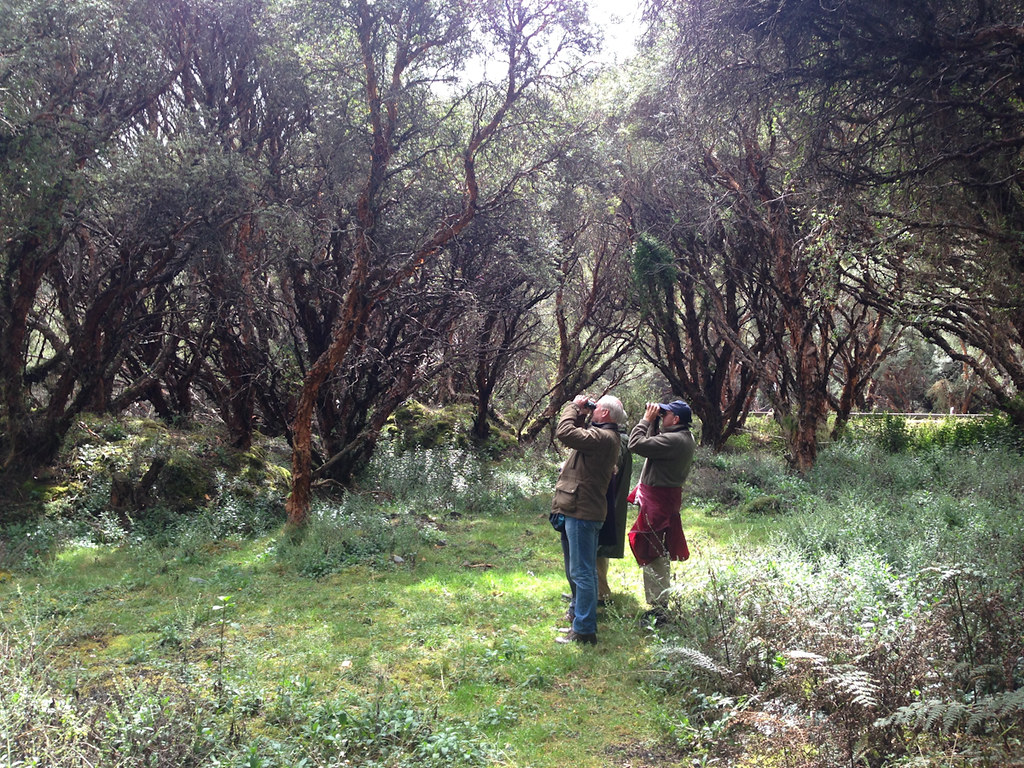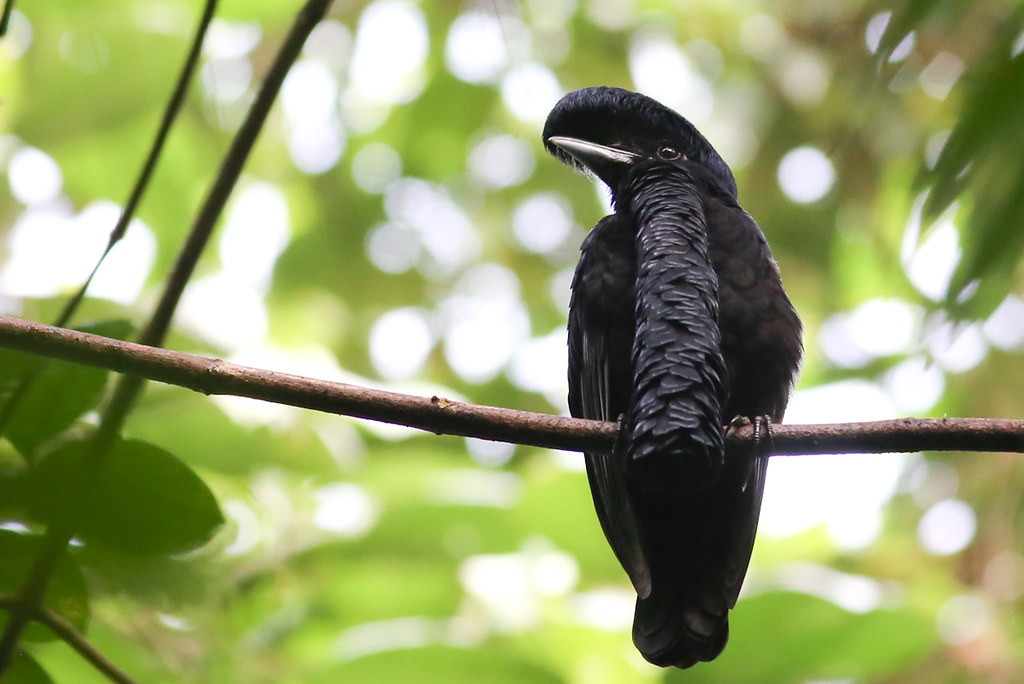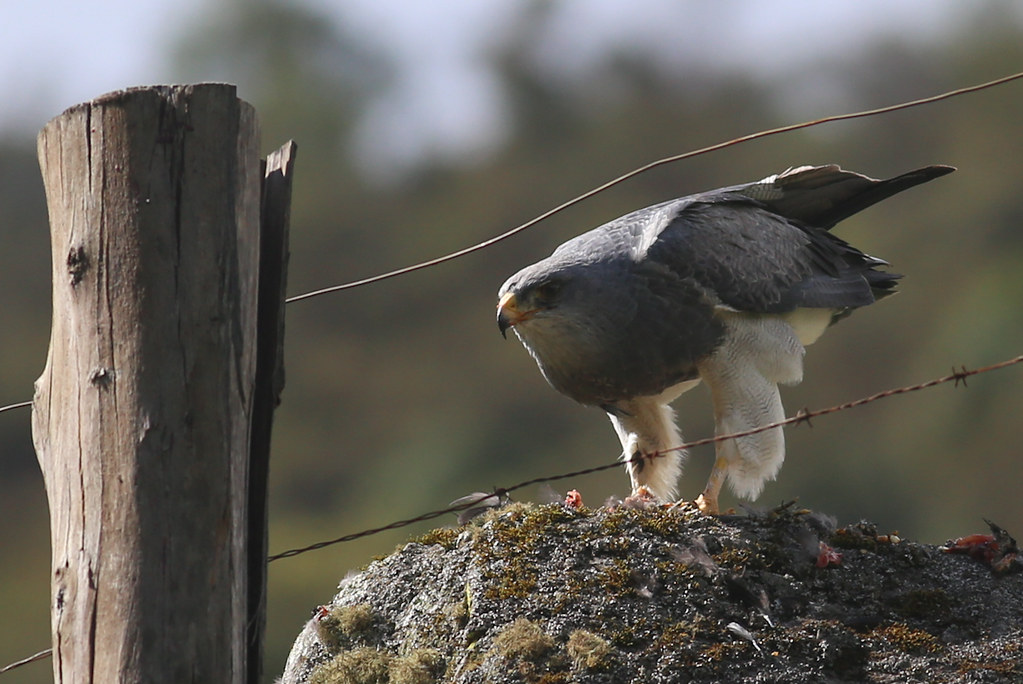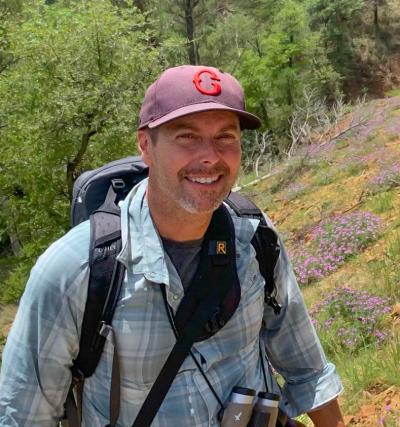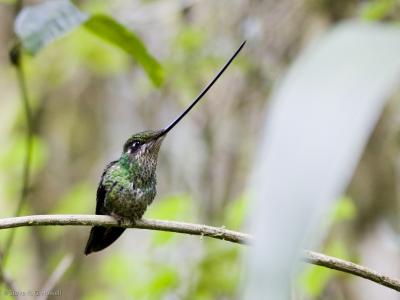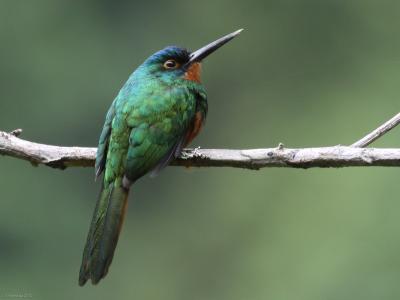Ecuador: The South
-
Oct 26 to Nov 12 2024
Jon Feenstra
-
Nov 1-18, 2025
Jon Feenstra
2025 Tour Price to be Determined
2025 Tour Price to be Determined
Although Ecuador is renowned for epic birding, the south stands out like a string of pearls—accessible and vastly different habitats supporting an astounding diversity of species and most of this small country’s endemics. We’ll sample these habitats, from the paramo above treeline in the high Andes, to the rainforest of the Amazonian foothills, to the elfin forest and lush cloud forest of the southeast, to the dry thorn scrub and deciduous forest of the southwest, and to the edge of mangrove woodland along the coast. Each has its own specialty birds, and each is close by comfortable and often brilliantly situated accommodation. This tour is perfectly set up for a memorable two-and-a-half weeks of birding.
Day 1: Everyone should arrive in Guayaquil by this evening for our introductory dinner. Night in Guayaquil.
Day 2: We’ll start the tour birding south of Guayaquil in the diverse coastal forest reserve at Manglares-Churute. This remnant mangrove forest bordered by dry forest and agricultural fields (rice paddies) is awash with interesting bird life and we have chances here for the southwestern forest specialties like Jet Antbird, Baird’s Flycatcher, and Orange-crowned Euphonia. Further, the rice fields and wetlands often have waders and shorebirds and Horned Screamers and unbelievable numbers of Snail Kites, and the mangrove forests have Mangrove Yellow Warbler. We’ll continue south from there into the low foothill rainforest of Jocotoco’s Buenaventura Reserve and the very comfortable Umbrellabird Lodge.
Day 3: The Buenaventura Reserve protects some of the most threatened forest in the country, and the drive there through mostly cleared pasture makes one appreciate the value of this spectacular piece of forest. We’ll have breakfast to the sounds of distant Howler Monkeys and squabbling hummingbirds before we take a hike to look for the namesake of the lodge: the amazing Long-wattled Umbrellabird which has a lek nearby. Its foghorn call is often heard, and we should be able to find one or more sitting unobtrusively in the forest sub-canopy.
The reserve also protects the scarce and local El Oro Parakeet, which we have a chance of seeing at the upper end of the reserve. We may get to see a few Club-winged Manakins displaying or a White-tipped Sicklebill tap into a heliconia flower. We could run into Gray-backed Hawk, Barred Puffbird, or Ochraceous Attila among throngs of other birds. The fruit feeders around Umbrellabird Lodge’s dining area can attract tanagers, araçaris, and coatis, and its hummingbird feeders are among the best in Ecuador. Night at Umbrellabird Lodge.
Day 4-5: After another morning of birding the rainforest, we’ll depart Buenaventura for a very different habitat, spending the next two days birding dry country—tropical deciduous forests and arid thornscrub—for the specialty birds of this seemingly strange habitat in a country mostly known for being lush and green. We’ll bird the Jorupe Reserve, another Jocotoco Foundation property, and spend two nights at the Jorupe Reserve’s Urraca Lodge. Notable birds to look for include Henna-hooded Foliage-Gleaner, Watkins’s Antpitta, Blackish-headed Spinetail, and Ecuadorian Piculet – but, even the fairly common species like Whooping Motmot, Scarlet-backed Woodpecker, Speckle-breasted Wren, and Chapman’s Antshrike are worthy distractions. The feeders at the lodge are usually busy in the morning with Rufous-headed Chachalacas, Blue Ground-Doves, White-tailed Jays, and Plumbeous-backed Thrushes. Nights at Urraca Lodge.
Day 6: Leaving Jorupe, we’ll travel across more arid country, but spending the morning in the high-elevation stunted forest of the tiny Utuana Reserve. Here we hope for Rufous-necked Foliage-Gleaner, Chapman’s Antshrike, and Glossy-black Thrush. The hummingbird feeders here usually have lots of Purple-throated Sunangels and Rainbow Starfrontlets. Descending from Utuana en route to the city of Loja, we’ll stop in the lower thornscrub for Tumbes Sparrow and the sneaky, but spectacular Elegant Crescentchest. Night in Loja.
Day 7: Today will be a varied day, beginning with the high-elevation part of Podocarpus National Park in the cloud forest of the Cajanuma sector just south of Loja, where we could find Equatorial Antpitta, Chusquea Tapaculo, Gray-breasted Mountain-Toucan, and perhaps a couple of flashy tanager flocks with the sublime Golden-crowned Tanager and ridiculous Grass-green Tanager catching the eye. After the morning there, things change fast, and we’ll first descend through arid, scrubby valleys, where Croaking Ground-Doves and Purple-collared Woodstars are possible, and finally we’ll go back up to reach the very humid high-elevation woodland of the Jocotoco Foundation’s wonderful Tapichalaca Reserve. Night at the homey Casa Simpson.
Day 8: At Casa Simpson we’re only steps away from excellent birding, starting with the hummingbird feeders on the front porch and perhaps Bearded Guans in the driveway. Surrounding the lodge, the Tapichalaca Reserve is the home of the flagship species of the Jocotoco nonprofit organization, and we’ll walk the forest trail to where the huge, spectacular Jocotoco Antpitta is now coming to earthworms at a feeding station. Golden-plumed Parakeets, White-throated Screech-Owl, Chestnut-naped Antpitta, Black-throated Tody-Tyrant, Dusky Piha, and White-capped Tanager are also possible while we wander the roads and trails that pass through the reserve. Also easily accessible from Casa Simpson are the upper reaches of the Río Marañon watershed, which flows south through the Amazonian foothills of Peru and marks a major ecological divide. Only a touch of this watershed enters the far southeast of Ecuador, and here we can find birds at the edge of their range, such as Black-faced Tanager, Marañon Thrush, and Rufous-fronted Thornbird. Night at Casa Simpson.
Day 9: After a final morning in the Tapichalaca Reserve and perhaps another stop back in upper Podocarpus National Park, we’ll end our day at Copalinga Lodge outside of the town of Zamora in the Amazonian foothills. Night at Copalinga Lodge.
Day 10: The charming Copalinga Lodge lies along the Río Bombuscaro at the eastern edge of the vast Podocarpus National Park. An easy trail along the river permits access to this lower elevation part of the park, and the list of potential birds is impressive. The brilliant Coppery-chested Jacamar and the local White-necked Parakeet are possible, as are more subtle species such as Black-streaked Puffbird and the recently described Foothill Elaenia. The grounds of Copalinga Lodge are superb for birding as well: fruit feeders can attract tanagers, euphonias, Speckled Chachalacas, and Red-crested Finch, Andean Cock-of-the-rock sometimes feasts in the palms and cecropias, and Little Woodstar occasionally visits the verbena. There is also a bird-feeding station back off in the woods that attracts a Gray Tinamou. Night at Copalinga Lodge.
Day 11: After a morning of birding around the lodge or back at the park, we’ll drive farther east. As the elevation sinks toward lower Amazonian foothill habitat, we could encounter Green-backed Trogon, Long-tailed Tyrant, raucous Black-capped Donacobius, and a few new tanagers like Turquoise, Masked, and Yellow-bellied. We’ll reach our lodge, Cabañas Yankuam, in time to settle in and perhaps do a little birding before dinner (in the late afternoon there are often White-tipped Swifts flying against the cliffs). Night at Cabañas Yankuam.
Day 12: Cabañas Yankuam lies along the Río Nangaritza in the Cordillera del Condor, a special habitat on a sedimentary stone tepui spur ridge of the Andes and home to near-endemic species and others at range limits or in isolated populations. Orange-throated Tanager is striking and will be a species for which we will have particular focus, but other likely prizes include Purplish Jacamar, Zimmer’s Antbird, and Gray-tailed Piha. In these primeval forests literally at the end of the road, Black-and-white Tody-Flycatcher and Fiery-throated Fruiteater are resident, and Ecuadorian Tyrannulets are almost common. Other birds occasionally seen along the road here are Lemon-throated Barbet, Yellow-backed Tanager, Slaty-capped Shrike-Vireo, and White-bellied Pygmy-Tyrant, yet another bird known in Ecuador only from this location. One feels on the verge of a great discovery every step of the way in the forests of this remote locale. Night at Cabañas Yankuam.
Day 13: We’ll bird the area around Cabañas Yankuam this morning before returning west and back up into the mountains. Night in Loja.
Days 14: From Loja we’ll go north to bird some high elevation forests near the town of Saraguro. We’ll keep an eye and ear out for tanager flocks, and we might bump into some mountain specialties like Glowing Puffleg, Mouse-colored Thistletail, or Loja Tapaculo. Leaving here, we’ll get even more mountainous and drive west deep into the Andean ridges to the remote mountaintop of Cerro de Arcos. If there is good weather in the afternoon we will make our first attempt at finding Blue-throated Hillstar, a hummingbird only first discovered in 2017 and known only from this location. Night at Casa Refugio Cerro de Arcos.
Day 15: We will spend the morning birding the area around the lodge, where, in addition to the Blue-throated Hillstar, other above tree-line specialties can be found. Jameson’s Snipe is often calling in the pre-dawn around the lodge and we may be able to track one down. Streak-backed Canastero, Black-billed Shrike-Tyrant, and both Mountain and Carunculated Caracaras are all possible. The hummingbird feeders around the lodge can have Shining Sunbeam, Great Sapphirewing, and Virdian Metaltail. We will stay until lunch then drop north through some desolate rain-shadow terrain toward the acacia woodlands of the scenic Yunguilla Valley. Night in La Union.
Day 16: We’ll start in the acacia woodlands of the Yunguilla Reserve that protects the tiny range of the critically endangered Pale-headed Brushfinch, a species rediscovered after being unrecorded for decades. They’re fairly common in the shrubby parts of the reserve and usually come in to the bird feeder, as often does Gray-browed Brushfinch and sometimes even a Chestnut-crowned Antpitta. From here we’ll drive up and north to the edge of El Cajas National Park on the outskirts of Cuenca, Ecuador’s third-largest city. Time permitting, we may stop on the way up at one of the “miradors” for a look out over the scenic countryside or pop into some polylepis woodland for a shot at a Giant Conebill. Night near Cuenca.
Day 17: Today we’ll be out birding near and above tree-line in El Cajas National Park, where we can expect such characteristic high-elevation species as Tawny Antpitta, Blue-mantled Thornbill, Chestnut-winged and Stout-billed Cinclodes, and Tit-like Dacnis, and we can at least hope for the endemic hummingbirds, Ecuadorian Hillstar and Violet-throated Metaltail, all against the dazzling backdrop of the high Andes. Depending on the weather and time, we may make a few last stops in our afternoon drive to Guayaquil for our final night in Ecuador. Night in Guayaquil.
Day 18: The tour concludes this morning in Guayaquil.
Note: The information presented below has been extracted from our formal General Information for this tour. It covers topics we feel potential registrants may wish to consider before booking space. The complete General Information for this tour will be sent to all tour registrants and of course, supplemental information, if needed, is available from the WINGS office.
ENTERING ECUADOR: Ecuadorian authorities require a passport that is valid for at least six months after the date of your arrival in Ecuador. Visas are not required for U.S. and Canadian citizens. Citizens of other countries should contact their nearest Ecuadorian Embassy or Consulate. Tourist cards are prepared by your arrival airline.
Proof of a current Yellow Fever vaccination is required only if one is entering Ecuador directly from a country where the disease is endemic.
COUNTRY INFORMATION: You can review the U.S. Department of State Country Specific Travel Information here: https://travel.state.gov/content/travel.html and the CIA World Factbook here: https://www.cia.gov/the-world-factbook/. Review foreign travel advice from the UK government here: https://www.gov.uk/foreign-travel-advice and travel advice and advisories from the Government of Canada here: https://travel.gc.ca/travelling/advisories.
PACE OF THE TOUR: This is intended as a moderate tour with slow walking and periods of standing and sitting, though the days may still be long. Daylight on the equator lasts only 12 hours and birds are most active in the early morning. Early starts are imperative, although these may be counteracted on most days by a post-lunch siesta or a couple of hours of free time before dinner. The majority of the birding will be done on foot from dirt roads and along trails.
While birding on roads, we’ll be moving slowly (birding speed) with the tour van following us. On several days we’ll be walk groomed forest trails, the longest of which are along the Rio Bombuscaro at Podocarpus National Park and a loop trail at Reserva Tapichalaca. The Rio Bombuscaro trail is about 3km in each direction, and the loop trail at Tapichalaca totals approximately 4km. Each have rolling hills and some steps but are well maintained for use by birding tourists. If we have a rainy period, the trails will be muddy and may have some slick spots. Please be prepared. A collapsible walking stick is often useful.
On several days, we’ll bird away from the lodge packing a box lunch, and returning in the late afternoon for dinner. On days when not staying at an “eco-lodge” with a kitchen open early for our needs, we may also leave the hotel packing breakfast or with a planned snack stop. There will be at least one optional after-dinner owling excursion.
HEALTH: The Centers for Disease Control and Prevention (CDC) recommends that you be up to date on routine vaccines before every trip. These vaccines include measles-mumps-rubella (MMR) vaccine, diphtheria-tetanus-pertussis vaccine, varicella (chickenpox) vaccine, polio vaccine, and your yearly flu shot.
They further suggest most visitors also acquire protection for Hepatitis A and Typhoid.
Yellow Fever: The CDC recommends Yellow Fever protection for visitors traveling in rural Ecuador.
Malaria: The CDC recommends Malaria protection for visitors traveling in Ecuador below 4900 feet (Most of our lodging is below this elevation)
Please consult with your physician well in advance of your tour’s departure as some medications must be initiated weeks before the period of possible exposure.
The most current information about travelers’ health recommendations can be found on the CDC’s website here: https://wwwnc.cdc.gov/travel/destinations/list
Altitude: While visiting El Cajas, Cerro de Arcos, and parts of Podocarpus National Parks, we will be some birding in elfin forest and paramo between 10,000 and 13,000 feet. We will be staying one night at Cerro de Arcos at 3600m (12,000 ft) elevation. Anyone with a history of heart, lung, or previous altitude problems should discuss it with their physician.
Insects: Biting insects are often present, but mostly only a minor problem in the lower elevations of the tour. We recommend using insect repellents with a high concentration of DEET. Reserva Buenaventura and Manglares-Churute, both visited during the latter half of the tour, often have aggressive mosquitos.
Smoking: Smoking is prohibited in the vehicles or when the group is gathered for meals, checklists, etc. If you are sharing a room with a nonsmoker, please do not smoke in the room. If you smoke in the field, do so well away and downwind from the group. If any location where the group is gathered has a stricter policy than the WINGS policy, that stricter policy will prevail.
Note: At each of our lodges, smoking is prohibited inside the buildings.
Food Allergies / Requirements: We cannot guarantee that all food allergies can be accommodated at every destination. Participants with significant food allergies or special dietary requirements should bring appropriate foods with them for those times when their needs cannot be met. Announced meal times are always approximate depending on how the day unfolds. Participants who need to eat according to a fixed schedule should bring supplemental food. Please contact the WINGS office if you have any questions.
Miscellaneous: We avoid tap water, purified water is readily available, and we stay in hotels and lodges that routinely host foreign visitors. However one can never completely escape the risk of parasites or infections. You may wish to bring a broad-spectrum antibiotic in case of stubborn bacterial infections and an anti-diarrhea medication such as Immodium.
CLIMATE: Due to the wide range of habitats and elevations visited on this tour participants should be prepared for an equally wide range of weather. The higher elevation areas around Cuenca can be crisp and cool with chilly nights and pleasantly warm days. Nights at Casa Simpson and Casa Refugio Cerro de Arcos can also be chilly and the humid weather there can make it feel especially cool. For the most part, temperatures will be warm during the day (75 F, 24 C), and pleasantly cool at night (60-65 F, 15-18 C). The lower elevations will likely be hotter. Though this tour technically takes place during the dry season, rain is always possible anywhere on the tour. Sunburn is also something of which to be always mindful and the strong tropical sun can be harsh on even overcast days.
ACCOMMODATION: Copalinga Lodge, Cabanas Yankuam, Casa Simpson, Urraca Lodge, and Umbrellabird Lodge are comfortable lodges catering to foreign tourists and birding groups. At all of the lodges, each room has a private bathroom and hot water, though you may need to bring your own shampoo at Copalinga and Cabanas Yankuam. Each lodge is also situated within its own forest reserve allowing immediate access to hummingbird feeders and excellent birding.
Though we try to schedule our tour when other large groups will not be present, depending on the situation, single travelers may need to double-up in a room with another participant at the smaller lodges.
Internet: Wireless internet access is available in the dining areas of Copalinga, Cabanas Yankuam, Casa Simpson, Hosteria Jardin del Valle, Urraca Lodge, and Umbrellabird Lodge and throughout our city hotels in Loja and Guayaquil. Internet and cell phone reception are not currently available at Casa Refugio Cerro de Arcos.
FOOD: Meals throughout are very good, with lots of vegetables, great soups, fruit juices and various salads to accompany the fresh meat, chicken and fish. Vegetarians can be accommodated, but please let us know in advance.
TRANSPORTATION: We’ll use nine to 15 passenger vans depending on group size.
2023 Narrative
With hardly a straight road or flat ground in sight, we drove for about 4000km covering a vast swath of southern Ecuador starting and ending in Guayaquil. We stopped and birded at the great reserves and parks from the mangroves of the Pacific coast to the rainforests of the remote Cordillera del Condor, and the arid thornscrub and dry-forests of the Tumbesian desert of the southwest, plus various mountaintops, valleys, rain shadows, wetlands, random roadsides, and the grounds and bird feeders of fine eco-lodges. We even snuck into Peru for a couple of hours and ticked a few birds there. Covering the many diverse habitats, it’s no wonder that the bird list went well above 500 species, and the highlights included Jocotoco Antpitta, Gray Tinamou, Gray-breasted Mountain-Toucan, Orange-throated Tanager, Long-wattled Umbrellabird, and Blue-throated Hillstar among other rare, endemic, difficult, and some really flashy-looking birds.
The day began by getting out of Guayaquil before it woke up and traffic clogged the roads. But, we didn’t have to go too far. In the tropical deciduous forest on the edge of the extant mangroves lies Manglares-Churute National Park, and our first stop of the day. The special Jet Antbird took some work, but other things like bright Black-faced Dacnis and Great Antshrike and a Peruvian Pygmy-Owl just came to us. We moved from forest to wetland and saw a literal flock of hundreds of swarming Snail Kites. They were everywhere, and after the swarm they settled into the trees in such a way that branches bent and there was no room for anything else. Their chattering was complemented by the tootling and honking of a half-dozen Horned Screamers perched in nearby bushes. We then drove a bit and stopped in a little fishing town where we got close looks at both Fulvous and Black-bellied Whistling-Ducks, hundreds of herons, egrets, and ibis, Roseate Spoonbills, and Wood Storks. Landbirds there were good, too, with a Baird’s Flycatcher that materialized in front of us, and a flock of Chestnut-throated Seedeaters out in the weeds. Though the goal of the day was to get to Umbrellabird Lodge, the birding along the way on our first day out was just splendid.
Our second day of birding was our first day of “big hits.” The morning was just generally busy with tanager flocks, mobs of hummingbirds, and some fly-by El Oro Parakeets. The hummingbirds included some crowd favorites like Violet-tailed Sylph and Green Thorntail, and the tanagers were the likes of Golden Tanager, Beryl-spangled Tanager, and Bay-headed Tanager. We also found a few Club-winged Manakins at their business. But, the big hit came late in the afternoon on a rainy walk into the jungle where we encountered a couple of the bizarre and spectacular Long-wattled Umbrellabirds. Only in a place like Ecuador with every tiny ecological niche filled could something with a foot-long retractable wattle fly breezily through the forest. It was amazing.
The next day saw another transition, this time from the wet western rainforest to the dry forest of southern Loja. The morning started in the rain and fog of Reserva Buenaventura. We mostly stuck around under the roof and watched hummingbirds and the light flocks that drifted by through the trees. Among the throngs of hummingbirds, we counted only a single Brown Violetear and followed it about its business. Below, near the ground, were Gray-and-gold Warblers, a feisty Buff-rumped Warbler, and a Bay Wren that was pretty enough for a thicket skulker to have been worth the work. Leaving the rainforest, we passed over some ridges into a very different landscape wherein squat, gnarled ceibo trees poked up above the acacia thornscrub and the ground was dusty and crinkled with dry leaves. We made a couple of quick stops before getting to the lodge, and were rewarded with a pair of White-headed Brushfinches. Settling into the lodge we ate dinner to the sounds of Pale-browed Tinamous whistling the forest around us.
We spent a full day birding the dry forest. The fruit feeders outside of the lodge were piled high with Rufous-headed Chachalacas, and there were a lot of Blue Ground-Doves around, though they were mostly quietly stationed in the trees. Our walks through the forest encountered pulses of birds that included dry forest specialties like Blackish-headed Spinetail, Ecuadorian Piculet, and charming little Scarlet-backed Woodpeckers. Some other highlights included a gaggle of White-winged Brushfinches and a formidable array of raptors like King Vulture, Gray-backed Hawk, Short-tailed Hawk, Zone-tailed Hawk, Harris’s Hawk, and Savanna Hawk. Even in this hot, dry weather, the birds were on.
The desert adventure continued with both high elevations and low. We started in some mossy forest at nearly 2000 meters elevation. There was a big, cool Ecuadorian Trogon, while swift Rufous-necked Foliage-Gleaners were darting about, and Blackish Tapaculos were being difficult. Hummingbirds were fancy with showy Rainbow Starfrontlets dominating the scene. In even more arid country we had nice looks at the truly elegant Elegant Crescentchest and the more (much more) subtle Marañon Tyrannulets did their subtle things. From the desert wilds we arrived at our big city high-rise hotel in urban Loja for a fine dinner and a bottle of wine.
The mountains treated us well today. We started in the upper elevations of Podocarpus National Park and found big, cool things like Turquoise Jays, Hooded Mountain-Tanagers, and a very cooperative Masked Trogon. We also did well with little things, including sublime Golden-crowned Tanager, a scarce Red-hooded Tanager, and a shockingly well-seen Chusquea Tapaculo. There were also hummingbirds – three species of sunangel, striking Collared Incas, and a few Mountain Velvetbreast to name the highlights. The only complaints were that the sunangels sat in the shade, the redstarts weren’t red, and the thistletail’s tail was missing and therefore not very thistle-y. We arrived in the afternoon to watch Bearded Guans in front of our lodge before the night in Reserva Tapichalaca.
Though we visit a number of Jocotoco Foundation reserves on this tour, there is only one in which the Jocotoco Antpitta, flagship species of the reserve system and conservation foundation, can be found. And, find it we did. The Big Daddy himself. He even chased off a Chestnut-naped (lowly peasant) Antpitta to assert his confidence at total coolness. Otherwise, it was also a day of good things. Gray-breasted Mountain-Toucan, Grass-green Tanager, Rufous-crowned Tody-Flycatcher, and Glossy-black Thrush were other cloud forest goodies. In the afternoon we followed the highway to lower elevations in the Marañon watershed and found some lowland things like our first tanager explosion: Paradise Tanager, Golden-eared Tanager, Blue-necked Tanager, Silvery Tanager, Blue-gray Tanager, Palm Tanager, and Black-faced Tanager with Black-faced and Blue Dacnises on the side.
Then we had a rainy day, but it fortunately fell on a day with a lot of driving and not as much birding. We, with too much optimism, tried some high elevation birding, but the howling wind, blowing fog, and general unpleasantness scared us off. We managed fine looks at the rainbow beard of a Rainbow-bearded Thornbill, but the further birds were lost in the fog. We dried out at lunch, but it didn’t last long. We watched some White-capped Dippers and a female Torrent Duck in the whitewater, but rain scared us off again. Fortunately, we then weren’t far from the porch and feeders of Copalinga Lodge. We finished out our day in the dumping rain watching Violet-fronted Brilliants shine in the dim light, an Orange-billed Sparrow scratch around, and hot coffee in our mugs.
The next day we spent in the lower elevations of Podocarpus National Park along the Rio Bombuscaro outside of the town of Zamora. We began with a Fasciated Tiger-Heron on a rock at a small stream crossing. Within the forest, a totally different mix of birds awaited us, with Paradise, Spotted, Blue-necked, Bay-headed Tanagers about. We saw a Coppery-chested Jacamar bringing food to its nest. And, we connected with a pair of Foothill Elaenias, a bird new to science only about twenty years ago. Back at the lodge, we saw some more tanagers and hummingbirds before heading into the forest for the special show of a Gray Tinamou that waits for some corn every evening. It’s a primordial-looking bird, a window back into the age of dinosaurs (but also kind of looks like a watermelon on legs).
Going down in elevation to the low Amazonian foothills in the Rio Nangartiza valley we encountered another new group of birds. We had some classics like Channel-billed Toucans, and some equally exotic-looking things like Gilded Barbet and Yellow-tufted Woodpecker. And, sometimes, even when seeing a lot of birds, there is time to notice the little things, the little stories that are part of observing wildlife. We watched a pair of Golden-faced Tyrannulets dive-bombing a Ruddy Pigeon. We couldn’t find a nest, but those two little flycatchers were very upset and the pigeon seemed to show no effect. Similarly inexplicable, we watched a Violaceous Jay fly a long way over the jungle in pursuit of a Greater Yellow-headed Vulture. Perhaps both were instances of mistaken identity. The Blue-black Grassquit doing his funny jump while he sang, however, is just what those things do.
Our full day in the Nangaritza Valley was a whirlwind of birds. It was hard to remember at dinner what we had been seeing that morning! Tanagers were fancy with Opal-rumped, Flame-crested, and Magpie Tanagers among dozens of individuals of a dozen other species. We had great looks at a few Purplish Jacamars and some new toucans: Golden-collared Toucanet, Ivory-billed Aracari, and Chestnut-eared Aracari. The Golden-collared Toucanet was a standout in that it perched in a dead tree and called for a while, jerking its body and bill around as it released its guttural squawk. We even got into the deep dark woods to winkle out some interior forest birds and ended up seeing White-browed Antbird, Zimmer’s Antbird, and Foothill Stipplethroat.
Before leaving the lowlands this day we had a couple of outstanding missions. Though the Orange-throated Tanager has become harder to find, our work was rewarded and we found one singing loudly from a tree over the road. It’s not just a special species with a tiny range, it’s also spectacular. Our second mission was a stealthy invasion of Peru to tick a few secret birds. Perhaps unbeknownst to anyone in Peru, the road in this remote part of Ecuador crosses the border for about 300m and gives us a chance to up our international birding game. We got there and found some birds. Our favorites were a pair of Yellow-bellied Dacnises, including a female building a nest on a tree fern. Another favorite were a pair of Spot-backed Antbirds, one of the best-looking antbirds and pleasantly well-seen by everyone.
With warm thoughts in our head we made the ascent from the low humid forest to the highlands. We started in some high elevation “temperate” forest with some spectacular tanager flocks. There were dozens of Masked Flowerpiercers moving about and nearly as many Lacrimose Mountain Tanagers. At one point we had a scope view with Scarlet-bellied Mountain Tanager, Lacrimose Mountain Tanager, Golden Grosbeak, and Yellow-breasted Brushfinch. And another view with Superciliaried Hemispingus with Blue-and-black Tanagers. It was cold and rainy, but when the birding is good, it doesn’t seem to matter. We climbed further uphill from there to the remote paramó mountaintop of Cerro de Arcos. There we saw a few of the recently discovered Blue-throated Hillstars.
Our morning for hillstar part 2 was successful, but the brisk mountain weather was perhaps a bit on the extra brisk side with howling wind and blowing fog. The hillstar showed, though, and so did the other cool high mountain things. We saw a few Tawny Antpittas including one that ran across the road in front of us, and a few Paramo Pipits doing pipit things. At the lodge a Great Sapphirewing was being great while a Shining Sunbeam (one among many around) sat on a nest up in the rafters of the building. Before our descent, some of us got to see an Andean Condor drift overhead. The descent was a radical change – from the cool lush paramo to barren arid scrubland, reminiscent of the Badlands of South Dakota. There are birds there, too, though, and we stopped for a Short-tailed Field Tyrant and a trio of Burrowing Owls before reaching the bottom and our next destination.
On an endemic roll, we began the next day at the Yunguilla Reserve wherein lies the core range of the critically endangered Pale-headed Brushfinch, a species once thought extinct. It’s not the most striking of birds, but it is special and another conservation success story as the tourists come from all over to a small reserve outside of a small town to see it. However, as usual, it’s not the only bird there! The reserve also hosted a couple of very accommodating Chestnut-crowned Antpittas and an equally accommodating Slaty-backed Nightingale-Thrush (eating white bread, of course). Leaving there we ascended to our next lodge of the tour on the edge of El Cajas National Park above the city of Cuenca. With a little poking around we located a Violet-throated Metaltail, a hummingbird species nearly endemic to the park. Andean Gulls wheeled about and we enjoyed a tasty dinner (and a birthday party) way up in the mountains.
Our last day of birding continued in the mountains in the brisk, high elevation air of El Cajas. We began in the lower part of the park (still at about 10,000 feet) and walked the edge of an alpine lake. A Virginia Rail wandering around out on the mudflat was an unexpected surprise among the other normal lake birds like Andean Teal, Yellow-billed Pintail, and Slate-colored Coot. We then moved to a higher part of the park, above 13,000 feet, for different things in the above-tree-line paramó. We had great looks at both male and female Ecuadorian Hillstar, especially nice after our recent encounters a few days ago with their new cousin. We also saw multiple Tawny Antpittas, a pleasure knowing how difficult their forest relatives are to see. Our final highlight of the mountains was a positively glowing Tit-like Dacnis, its saturated blue complemented by the look of texture its feathers gave it. All with the backdrop of rugged Andean peaks in all directions. These scenic heights were the last birding of this tour, and we dropped down through two distinct bands of fog and landed back down at sea level and the highway to Guayaquil. We wrapped up in the same hotel restaurant in which we started, five hundred and something birds later, and a whole lot of memorable travel.
Jon Feenstra demonstrated excellent leadership skills. As a bird trip leader, he has an amazing talent to identify hundreds and hundreds of birds by sound alone, and his visual identification skills are truly remarkable. All that, and he's a lot of fun! I would highly recommend any trip with Jon Feenstra.
- Susan G. on Ecuador: The South
*2024 tour will be run in reverse order to the published itinerary.
This tour is limited to seven participants and one WINGS leader.






